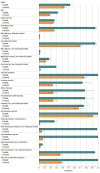Estimated Costs of Intervening in Health-Related Social Needs Detected in Primary Care
- PMID: 37252714
- PMCID: PMC10230374
- DOI: 10.1001/jamainternmed.2023.1964
Estimated Costs of Intervening in Health-Related Social Needs Detected in Primary Care
Abstract
Importance: Health-related social needs are increasingly being screened for in primary care practices, but it remains unclear how much additional financing is required to address those needs to improve health outcomes.
Objective: To estimate the cost of implementing evidence-based interventions to address social needs identified in primary care practices.
Design, setting, and participants: A decision analytical microsimulation of patients seen in primary care practices, using data on social needs from the National Center for Health Statistics from 2015 through 2018 (N = 19 225) was conducted. Primary care practices were categorized as federally qualified health centers (FQHCs), non-FQHC urban practices in high-poverty areas, non-FQHC rural practices in high-poverty areas, and practices in lower-poverty areas. Data analysis was performed from March 3 to December 16, 2022.
Intervention: Simulated evidence-based interventions of primary care-based screening and referral protocols, food assistance, housing programs, nonemergency medical transportation, and community-based care coordination.
Main outcomes and measures: The primary outcome was per-person per-month cost of interventions. Intervention costs that have existing federally funded financing mechanisms (eg, the Supplemental Nutrition Assistance Program) and costs without such an existing mechanism were tabulated.
Results: Of the population included in the analysis, the mean (SD) age was 34.4 (25.9) years, and 54.3% were female. Among people with food and housing needs, most were program eligible for federally funded programs, but had low enrollment (eg, due to inadequate program capacity), with 78.0% of people with housing needs being program eligible vs 24.0% enrolled, and 95.6% of people with food needs being program eligible vs 70.2% enrolled. Among those with transportation insecurity and care coordination needs, eligibility criteria limited enrollment (26.3% of those in need being program eligible for transportation programs, and 5.7% of those in need being program eligible for care coordination programs). The cost of providing evidence-based interventions for these 4 domains averaged $60 (95% CI, $55-$65) per member per month (including approximately $5 for screening and referral management in clinics), of which $27 (95% CI, $24-$31) (45.8%) was federally funded. While disproportionate funding was available to populations seen at FQHCs, populations seen at non-FQHC practices in high-poverty areas had larger funding gaps (intervention costs not borne by existing federal funding mechanisms).
Conclusions and relevance: In this decision analytical microsimulation study, food and housing interventions were limited by low enrollment among eligible people, whereas transportation and care coordination interventions were more limited by narrow eligibility criteria. Screening and referral management in primary care was a small expenditure relative to the cost of interventions to address social needs, and just under half of the costs of interventions were covered by existing federal funding mechanisms. These findings suggest that many resources are necessary to address social needs that fall largely outside of existing federal financing mechanisms.
Conflict of interest statement
Figures



Comment on
-
Addressing Health-Related Social Needs-Costs and Optimism.JAMA Intern Med. 2023 Aug 1;183(8):774-775. doi: 10.1001/jamainternmed.2023.1972. JAMA Intern Med. 2023. PMID: 37252719 No abstract available.
References
-
- Marmot M, Wilkinson R. Social Determinants of Health. Oxford University Press; 2005. doi: 10.1093/acprof:oso/9780198565895.001.0001 - DOI
-
- Tobin-Tyler E, Ahmad B. Marrying value-based payment and the social determinants of health through Medicaid ACOs: implications for policy and practice. Milbank Memorial Fund. 2020. Accessed December 9, 2022. https://www.milbank.org/publications/marrying-value-based-payment-and-th...
-
- National Academies of Sciences, Engineering, and Medicine . Integrating Social Care Into the Delivery of Health Care: Moving Upstream to Improve the Nation’s Health. National Academies Press; 2019. - PubMed

